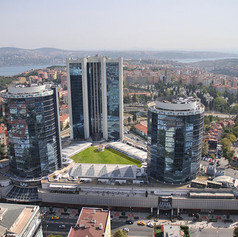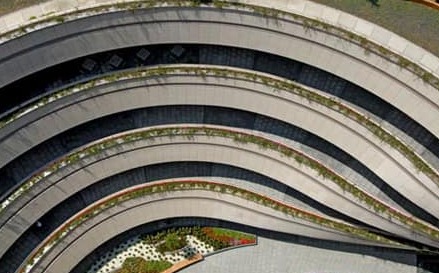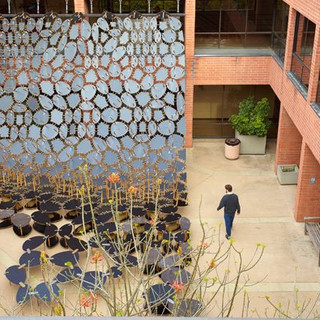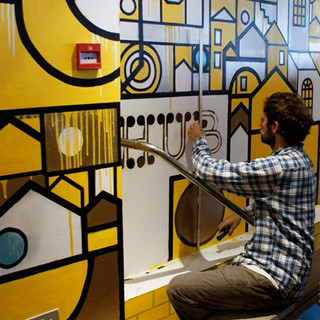Dear Mall Developer...
- jodieharburt

- Nov 23, 2017
- 8 min read

MAPIC had quite a pervasive advertising campaign going on this year, they popped up on my feed despite the fact I have no recollection of even doing a search regarding them. The main aim (for the uninitiated) of MAPIC is to bring together the retail and commercial property people from all over the world at the rather lovely location of Cannes, France. Whether you are a developer or a retailer or selling any product (like technology and infrastructure) you can attend and forge links. The video ad featured some big industry names talking about their goals, "network, close deals, meet friends, chat with clients, make money..." One guy mentioned the fact that entertainment is important as a part of the retail experience. Which brings me to my point. I wonder who of those retail space makers visit their mall creations as a human being (rather than as an invested party).
I ask dear sir/madam. Can't you do better? You create man traps and trip wires so people are tricked into spending what they earn (and what they can borrow) on things that are possibly unnecessary and often totally unsustainable. The individual merit of the goods on sale are arguably not your first concern, but the shopping experience should be. As architects, designers and developers we are very aware of the power that intelligent design can wield over the public, we can manipulate and brain wash just with the turn of a corridor and the flick of ambient light. Visitors to the malls are immersed in the 'come-spend-eat-spend some more - maybe be entertained - buy a coffee - have a nice day and come back soon' experience. Justifiably so you say, one has to cover the cost of providing this mega project to the community. One has to make profits or why invest so much? Ok, so my next question is this: Why should the valuable and finite resource of land and locality be used for projects that do not create community, do not have sustainable goals, do not give any thing back, do not educate or entertain (with a few rare and meager exceptions), do not have any charitable or altruistic basis, do not care and do not nurture?.
They just take the space, the money, the time, the land, the sense of community and the peace of mind (of those who can or can't afford)
Malls do not provide. They take. I'll give one tiny example of a private initiative that is attempting to give. The owners of a small, private, local school are presently not making money as it is still in the initial phase while they wait for the optimum number of paying pupils to enroll. This has not stopped them from providing various social responsibility projects, free lessons to local children and some full scholarships, they are also considering special needs and planning all kinds of events to integrate the school into the community. If this small business can do so much then surely the big business guys should long be doing the same in line with these three goals:
a) give back
b) interact with the community
c) thus create mutual benefit The decline in popularity of the mall despite the loss of alternative public space has given incentive to the mall developers and operational teams to come up with ways to increase customer satisfaction and thus footfall. Special deals and entertainment venues are being integrated but also a more dynamic environment is created with pop-ups and festival type events. While these are geared towards increasing the profits there are also ploys afoot to induce customer loyalty and track their behaviours using such methods as facial recognition for repeat visitors, customized offers and apps to aid everything from parking to cinema ticket acquisition.
Where is the community and the interaction, where is the giving back and why the false hood that it is not profitable to be sustainable.?
I look forward to the day when the mall's anchor tenant is a large, non profit, sustainable organization and the income for the retailers/mall owner is secondary spin off from this. Integrating office and residential space in mix use projects has proven effective and there are interesting examples where the mall is built around a focal point such as a train station, aquarium or a mosque. These add dimension and ergonomy, but rarely constitute the content of the mall itself. Present design and marketing of the shop mix and concept include such strategy as "bullet proof economics"*1 but what I'd like to hear about is bullet-proof ethics! The huge impact of these social hubs is ignored and all "that will yield higher visit and/or spend rates, and ultimately greater consumer loyalty"*1(read addiction) is considered the essence of a good mall.
Though they are renowned as being some of the best the malls here in Istanbul have made little attempt in terms of sustainability or consideration for the city's need for oxygen yet comprise store after store of stuff. Consumerism is shoved down our throats with little else to help us swallow it. Experts agree that "it is critical that malls be about much more than stores. We see the mix of tenant/public space moving from the current 70/30 to 60/40, or even 50/50"*1 and indeed it's a real improvement to see this reallocation of space, however it is essential to put the human experience and sustainable concern at the core of every design and operating manifesto.
Malls give architects an opportunity to showcase their skills, innovation, intellect and integrity, however they are often thwarted by the limiting beliefs of the developer. At least the physical presence of such buildings is a form of public art (in some cases) which should be emphasized by more art. Art, not as decoration, but in all forms as integrated intellect that would stimulate the minds of the shoppers.*2
The concept of entertainment as being "one and the same" as retail requires serious overhaul and should not be fed to the punters like a version of the fast food served on the food courts. While there is a necessity for convenient food and fun it is of huge relevance that the mall developers reconsider their roles in the real and profound phenomena of cultural design.*3 The influence developers and retailers wield over the general public is so huge that they should be required to work with experts and be held up to ethical scrutiny. The calculation of footfall, trend and behaviour analytics and the resulting algorithms prove the existence of conscious evolution, but are used to manipulate human response, the effects of which are exacerbated through the merge of retail space into the condensed and depleted public realm.
Each mall is a hub for popular culture, thus in designing a mall one is actually designing emerging culture and causing an effect upon the future of human kind.
While the purpose of the mall is to generate profits, it can not be ignored that a narrow view and realisation of the present growth-centric economy is non sustainable. Enlightenment regarding this is inducing change, but malls have it within their scope to be one of the pivot points of positive and public-centric improvement, which would be ultimately to the malls own benefit as well as for the better good.
Putting it bluntly: The urban public has been left without alternative and the shopping center/high street/mall, (basically the retail world) has brainwashed the masses into a dependence upon retail recreation. Many of the retail spaces could be used for the public and community, but they have been allocated the sole purpose of profitable gain. For this profit to be considered in any way ethical a reassessment of the legislation is essential. Mall developers here in Turkey may bleat out their defence citing the taxes they pay and the regulation that stipulates relinquishment of up to 40%*4 of the land to the 'municipality public share'. Despite this it is rare to see a tract of land used for the public benefit in the vicinity of a mall and we can surmise that the mall's demand upon local infrastructure uses up the allocated land for such services as roads and access. Better implementation of this regulation is essential, but does not solve the issue of the mall's internal content and role in society.
Even without constructs of altruism and rightness one wonders whether the self perpetuating mechanism of spend influence can simply keep plodding on without a big investment of innovation and human scale ideas. It is in the best interests of the investors to reconsider their role in these times of change and rapid evolution. In terms of competitive interests I believe that by setting the precedents in ethical mall trends the front runners will see their profit margins grow and they will be in a better/evolved position to face any decline in present system economical growth.
Here are some ideas as to how things can change in a mutually beneficial way: - Local/National administration must set new regulations for both retrofit (to ensure ongoing licenses) and for all new projects. - The public must be consulted and local associations must be more active and influential.
- New vision must evolve. Opportunity for dialogue and fusion need creating. MAPIC has potential.
- Cross pollination beyond retail world to such fields as sustainability, education, sociology etc.
Active legislation should ensure each shopping center has the following components:
- Sacrifice in terms of rental space is a prerequisite to having a licence to build or operate. All retail space must allocate a percentage towards the pure unadulterated betterment of the locality.
- Sustainable building criteria including retrofit where possible. (There is a tragic lack yet crucial necessity for ecological and sustainable practices from construction up to and including the nature of the retailers stock) - Green area. (Not just landscaped; some left wild, like wild grass areas, these can be upon roof tops and must be at least part accessible to everyone)
- Allocated space for urban vegetable gardens and stalls selling produce
- Recycling center and awareness
- Upcycling center (inc workshops and store selling products)
- Accessibility and design for special needs people*5 - Allocated space for revolving exhibitions (art, science, crafts etc) local artisans/schools/clubs given free space to have temporary exhibits.
- Art symposiums. Murals, installations, interactive art, sculpture and 3D, digital and video art. A budget allocated for art acquisition (which can rotate around malls globally) - Allocated space for charitable work. (These places can include both store fronts and cafes as well as out of sight workshops for kids, the elderly, adult education and disabled people. For example - workshop and store for bicycle repair/custom made bikes*6 - pottery/ceramics - painting studio - jewellery, textiles, crafts, cooking and patisserie workshops etc) - Allocated space for the display of the charity work that is created on site. - A cafe run entirely by disadvantaged or disabled people. - Meeting places used for the elderly and another for small kids. Frequent overlap of activities in these places ensure inter-generational interaction. - Childcare and activities of the kind that do a not allow the parents just to go off and shop but that instigate a healthy collaboration between the space and the new generation.
- Educational activities that integrate the space (urban gardens, workshops, retails areas etc) with the evolving minds of the children so that they will both enjoy the space more fully, feel connected and also be knowledgeable participants as they (the mall and the new generation) both evolve.
All the above can be integrated seamlessly into existing malls, the projects can be developed in alignment with new retail approach, the profits may even surge and certainly we, the shoppers and you dear sir/madam will have reason for your hearts to swell with pride.
Yours faithfully and with hope
A. Shopper
*2 - Maybe it has been proven that installed art slows shopper down and makes them spend less? If so it is in the malls best interests to make space for art and learn to work with a more enlightened customer. See my post Art (and why we need it)
*4 Public land can be used as roads, car parks, school, parks and mosques. (though often is not!)
*6 - This a bike repair place providing life skills to people with learning disabilities. Ipswich UK.
- Photo credits: Deaf India News. Mural A Side. Carole Turner Sculpture. Hoffman Hayes. Greenville Community Gardens. Arts Crafts Workshop 305. Zorlu. Kanyon. DDG Architecture. Bell Nogues Studio. Jacob Hashimoto. Stategic Meeting Partners.



























































Comments